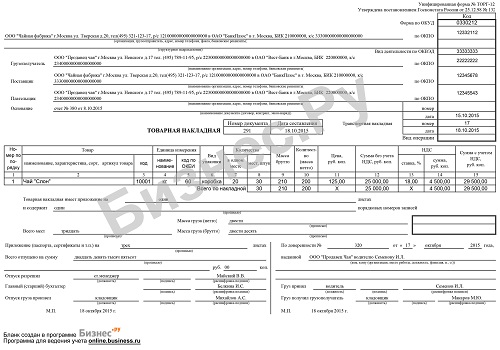A consignment note is a primary accounting document. Serves as a justification for writing off inventory items by the seller and for registering goods by the buyer.
The TORG-12 form has a unified form, which was approved by Decree of the State Statistics Committee of Russia dated December 25, 1998 No. 132. Since 2013, organizations have the right to develop their own form of consignment note, but it must contain all the necessary details.
Form and sample of consignment note TORG-12
Sample

Rules for filling out the TORG-12 form
Since the delivery note is checked by the tax authorities for VAT deductions, all the main columns in it must be filled out correctly:
- Names of organizations involved in the purchase and sale, their addresses, telephone numbers, account, BIC, code, OKPO codes (in the column on the right).
The organization that ships the goods is listed in the top line. This is either the supplier or its structural unit (the address of the unit is indicated), or, if delivery is carried out under the Supply Agreement through an intermediary, its coordinates are indicated.
The warehouse address is entered in the “Structural unit” line (or duplicated from the top line) if the goods were shipped from there.
The addresses of the Shipper and the Consignee are indicated as actual. Supplier and Payer are legal. - Basis for the transaction: agreement, work order, indicating its number and date of execution.
- Number and date of registration of the accompanying trade invoice.
- The number of the sales invoice itself and the date of its preparation. The terms of shipment of the goods must coincide with the real ones, so they are made either at the time of shipment or immediately after its completion.
- A tabular part with a description of the goods being shipped: name, price, quantity, weight, etc. Enterprises operating under UTII or simplified tax system do not fill out columns 13 and 15.
- The number of sheets of the invoice (“...has an attachment on...”) and the number of serial records of the goods.
- Total number of pieces (boxes, packaging, etc.), total net/gross weight.
- Lower left block: the number of documents attached to the goods, the total cost of the goods in words, signatures of the persons responsible for the shipment with a transcript: who authorized it, who directly released the goods, and the obligatory visa of the chief accountant of the enterprise.
- Bottom right block.
The line “Cargo accepted” is signed by the person who directly accepted the cargo according to the invoice. This is either the head of the enterprise himself, or an authorized employee secured by a power of attorney on behalf of the head. If a power of attorney has been issued to receive the cargo, indicate its number, date of preparation, as well as the position, full name and signature of the authorized person. Apply the company seal. If there is no seal, the receiver can sign a power of attorney with the seal of the supplier’s representative and register in TORG-12; This will be sufficient to confirm receipt of the cargo.
In the line “The cargo was received by the consignee,” there may be another person, for example, an employee of the accounting department of the parent organization-buyer, if the direct receiver represented the branch and accepted the cargo by proxy.
The delivery note is filled out by an authorized person (accounting employee, manager, seller, etc.). The information about the goods and the shipper in the consignment note must be identical to the information in the invoice.
If necessary, you can add additional fields and columns to the form, and even create your own invoice form, but with all the necessary fields.
If, after filling out TORG-12, an error or typo is discovered in it, it can be corrected by carefully crossing out the incorrect ones and entering the correct data, confirming them with a signature and the date when the changes were made. If there are many errors, the invoice is canceled and a new one is drawn up.
The TORG-12 consignment note is drawn up in two copies: one remains with the buyer, the other with all signatures is transferred to the supplier.
Example of a consignment note TORG-12 in electronic version
The legislation allows the use of an electronic form of the consignment note (Part 5, Article 9 of the Federal Law of December 6, 2011 No. 402-FZ). Filling it out is no different from filling out a paper form. The forms of XML files of electronic documents are approved by Orders of the Federal Tax Service of Russia dated 03/21/2012 NMB-7-6/172@ and MMB-7-6/36@ dated 01/30/2012.
Such invoices are also submitted to the tax authorities electronically.
Electronic invoice forms are certified with an electronic signature.
To use it, you must obtain a certificate and permission confirming the right of an authorized person to make electronic signatures.
On an electronic copy of TORG-12, one signature from the supplier and from the buyer is sufficient. However, the full names and positions of the responsible persons are also indicated.
Electronic documents are sent via the Internet. The driver carrying the cargo is issued a consignment note in form 1-T, which lists all the goods and their characteristics.
If the goods are transported by an intermediary organization, then in the electronic form TORG-12 the number and date of the TTN are entered by the seller, and the data of the power of attorney for the transportation of goods and the column “Cargo received” are filled out by the buyer, certifying them with his electronic signature.
The archive of electronic documents must be located on a separate computer (for example, in the accounting department) or on a special company server.